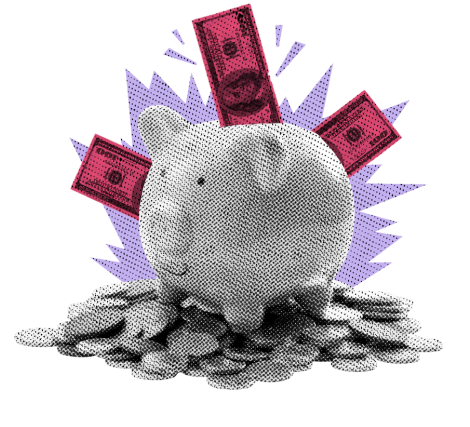
Market jitters, price hikes, and consumer fears—is the tariff threat overblown or about to hit home?
KEY TAKEAWAYS
- Tariffs are here, but not all are in full effect yet. China, steel, aluminum—yes. Mexico and Canada? Mostly on hold for now.
- Consumers don’t track GDP growth, but they do track prices. And they’re about to notice higher costs on iPhones, cars, and more.
- The market hates uncertainty more than bad news. Four weeks of losses are driven by fear of what might happen, not necessarily what has happened.
- Polls show the President’s approval remains strong. That means many Americans aren’t feeling the impact—yet.
- Tax policy is still an unknown. The market could swing wildly when Congress unveils its plans.
MY HOT TAKES
- The market is in full-on panic mode, even though much of this is still hypothetical.
- Consumers are already worried about inflation, and if tariffs hit their wallets, confidence could tank.
- The White House hasn’t shown its full hand yet—this could go in any direction.
- Uncertainty, not inflation, is the real enemy of the market right now.
- If you’re making a big purchase soon, now might be the time before prices go higher.
- President Trump has not even revealed his stimulus policies yet–those could be game changers.
- You can quote me: “Is it possible that all this market agitation has more to do with angst of not knowing and less about actual inflation?”
Bracing for impact. Not unlike my zillennial friends and kids, I am constantly scrolling and checking… but not the same things. No. I am constantly scrolling through prices of all things manufactured in China, Canada, and Mexico. Sure, I go on some side quests that include pet rescues and cooking, but for the most part it is prices that I am obsessed with. Of course, my obsession has been borne of this most recent, budding trade war between the US and some of its largest trading partners.
In case you haven’t noticed, there has been a lot of noise coming out of Washington DC regarding trade and tariffs. Or has there? “Wait, what do you mean, Mark,” you inquire? Well, you and I have a standing meeting each morning where we discuss, in-depth all things that affect the markets and the economy. What about everyone else?
Well, something like 60% of adult Americans own stock, with the top 10% wealthiest Americans owning 93% of stock. So, at least 40% of Americans don’t even own stocks. And of the 60% that do, around 12.6 million households care more than most (that is out of 126 million households). That is some rough, rough math, but I want you to walk away with the reality that not as many people are as sensitive to most of this stuff as we are.
To be clear, ALL AMERICANS are sensitive to price gains. In fact, in my experience, the wealthiest folks I know are the most concerned with the price of apples, eggs, chicken, etc. I always say you make a million dollars 32 cents at a time, and so do they apparently. I have also written that “recession is just a word” in the past. Not sure when, but if we spent some time, it was probably at least five or six years ago. If you are an average Joe or Jane, there is a 40% chance that you don’t own stock, and if you do, it is very little. You probably don’t know what the current GDP growth is. If I told you that the number that we talk about ALL THE TIME is an annualized quarterly growth figure, you might consider having me kicked out of the establishment. In other words, YOU DON’T CARE because it means nothing to your bottom line, unless of course you were worried about your job safety.
So, for a lot of Americans, unless their jobs are in peril or they own lots of stocks, it is quite possible that all this DC stress is none of your concern. That is most likely why the most recent poll (this morning) showed that the President had a 47% approval rating. In fact, an average of the most recent polls tracked by Real Clear Polling, show the President’s approval at 48.2%. To be clear, that is a fairly strong approval rating considering how busy Trump has been since inauguration. AND considering how the equity markets have behaved recently.
So, let’s take a quick step back and talk about what has been vexing the markets. Is it fair to say potential inflation from tariffs and increased possibility of an economic slowdown? Maybe, we should start with what new Trump tariffs are currently in force:
- 20% increase in tariffs on all imported goods from China
- 25% tariffs on all aluminum and steel imports
- 25% tariffs on all imports from Mexico and Canada NOT covered under the USMCA, which is not a lot. That includes a 10% tariff on Canadian energy products that are all put on hold as well.
- …really, that’s it.
On the broad Mexican and Canadian tariffs, most are currently on hold. Now that doesn’t mean that these will not go into effect sometime soon, but as it stands, importers of Avocados from Mexico are not being taxed by US Customs. BUT that is not to say that many items are not currently being taxed. iPhones made in China (most of them are), for example, are being taxed at 20%. So are all the sub-assemblies used in auto manufacturing, along with apparel made in China.
Also, being taxed at 25% is steel and aluminum. Imports account for nearly 47% of US aluminum consumption! That means almost half of all aluminum products made in the US will be affected by this tariff. Steel imports are much lower, around 13%. That said, items like cars, that are heavily reliant on steel, aluminum, and Chinese manufactured parts are likely to go up in price within the next quarter or so as newly manufactured vehicles fill up car lots. That is not good as cars are expensive and interest rates to finance them are well… not going down so fast. I don’t want to simplify it too much, but if you are thinking of buying a car, airplane, or spaceship, you might be paying more in the near future.
So, groceries are already expensive, and they may become more expensive if the President lets the original proposals go into enforcement. Cars are going to cost you more soon. Some electronic devices that rely on Chinese components will become more expensive soon, as well.
What is my point for all this? Well, let’s get back to the markets. The markets are now contemplating the worst-case scenario. Stocks have suffered 4 weeks of losses amidst growing volatility. Looking at the most recent Conference Board Consumer Confidence and last Friday’s University of Michigan Survey, consumers are worried about economic conditions and inflation. Now, whether conditions worsen, or inflation picks up, there is a chance that consumers will slow their spending. That would not be good. That IS how recessions actually happen. If the President follows through on all these promised tariffs, prices of most things that we buy will rise, and confidence will continue to drop making the chances of a recession much higher. But will he? That seems to be the biggest question.
Is it possible that all this market agitation has more to do with angst of not knowing and less about actual inflation? Well, today, maybe yes, but in a few weeks that may change. If we go back to those Polls, we note that the President only gets a 41% average positive rating on inflation and 43.7% average positive rating on the economy. Smaller but not bad–though they may change in coming weeks.
All this shows that there is still a lot of noise as very little has actually come to ground yet. This noise is good enough to shake the markets, but maybe not average Americans. If that is the case, we can expect the administration to keep trudging forward with its current strategy. Also, bear in mind, the Republican Congress and the President have not had a chance to reveal any tax legislation yet. When that occurs, we will see a big change in polling numbers–and markets. We have been talking a lot about the strike price of the Trump Put lately and it is clear that we have not yet found it. We should also be thinking about the Fed Put, because I am sure that the President is. But that is a discussion for another day. For now, don’t get caught up in all the noise. Do keep a close eye on actual prices of goods–and maybe try one of those pet rescue videos but be prepared to shed a tear or two.
FRIDAY’S MARKETS
Stocks rallied on Friday in the wake of Thursday’s ugly dip into correction territory. A key gauge of consumer confidence sent a clear message: consumers are losing confidence. 2-year Treasury Note yields climbed to reflect increased inflation concerns.

NEXT UP
- Empire Manufacturing (March) is expected to come in at -2.0, down from the prior reading of 5.7.
- Retail Sales (February) may have gained 0.6% after slipping by -0.9% in January.
- NAHB Housing Market Index (March) probably remained at 42 for a second straight month.
- Later this week: more housing numbers, more regional Fed reports, Leading Economic Index, FOMC Meeting. Download the attached weekly economic calendar.
.png)

